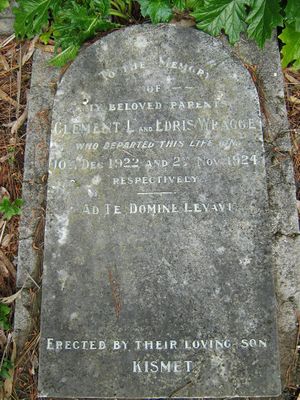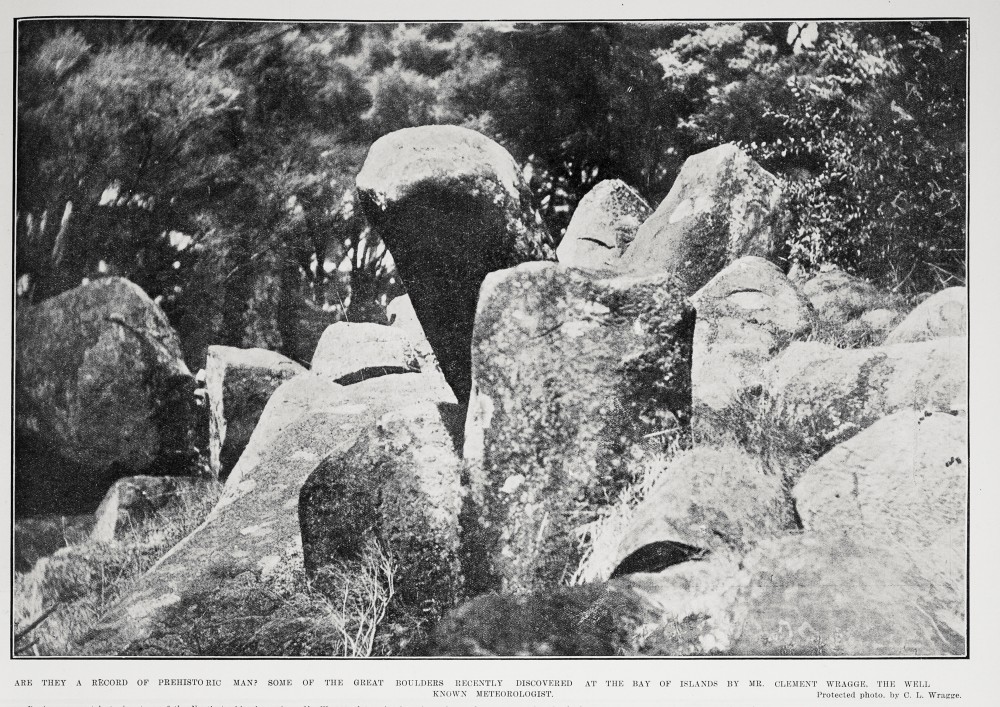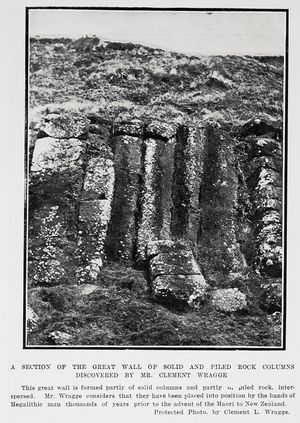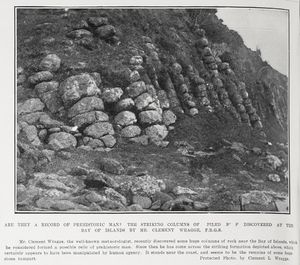Wragge Clement
Contents
Clement Lindley Wragge 1852 - 1922
Wragge's History
Clement Wragge By Sir Harold Nicholas, via Wikimedia Commons
Clement Wragge was British born and is best known for his contributions to meteorology. After one period of residence in Australia where he worked as a surveyor he returned to Britain and founded a weather observatory on Ben Nevis[1]. His subsequent career in Australia involved establishing further mountain top observatories and was meteorologist for the Queensland Government. Wragge's name has some international fame stemming from being the founder of the system of giving names to tropical cyclones. He is honoured as a meteorological pioneer in Australia[2][3].A comprehensive biography appeared in 2023 authored by Ian Frazer [4].
A strange memorial to him are two Stiger-Vortex cannons mounted in a park in Charleville [1][2], survivors of six which Wragge had built. These were used in 1902 here, and at Mt Morgan, in rain making attempts during the peak of the great Federation drought.
Wragge had independent means in the early part of his life. He travelled widely. He visited New Zealand in 1904 lecturing on meteorology and astronomy. A book on the south seas was one output from his travels[5]. On the trips reported in that book he visited New Caledonia, Rarotonga, Raiatea and Tahiti. Later visits include India and Ceylon (1907-08) and Tonga in 1911 (for an eclipse). Some secondary sources cite a visit to Easter Island, (e.g.[6]) but his autobiographical notes in the Auckland Museum library make no mention of such a visit, despite full listings of his other travels. Wragge moved to New Zealand in 1908, living in Birkenhead, Auckland from 1910 until his death there in 1922.
He travelled in New Zealand after settling here, lecturing on weather and astronomy and by 1915 was including in his lectures material on Easter Island and the ancient history of New Zealand[7].
He was a weather forecaster of repute. He lived at No. 8 Awanui Street Birkenhead in Auckland with an Anglo-Indian partner – who was apparently not his wife, at least by the conventions of the day. They created a tropical garden there, Waiata Tropical Gardens, where there was also a meteorological observatory. This was a successor to his like garden and observatory in Taringa, Brisbane. Wragge continued scientific lectures via the Wragge Institute and Museum at the same site. For a personal history of Wragge see Crocket[8].
Wragge was also a leading spiritualist. Frazer dates his adoption of Theosophy to 1891. By 1921 he was describing himself as "Minister of the Auckland Spiritual Scientists Church" and referring to both Theosophy and A.'.A.'.[9]. It is apparent that the cosmological and race origin ideas of Theosophy were deeply imbued in Wragge.
Spiritualism reportedly received a boost from the first world war as the survivors turned away from the complicity of the established churches[10]. He had lost a son at Gallipoli. Perhaps Wragge's church was part of that. At the time of his death, he was reportedly 'engaged upon a work of great value concerning the petroglyphs of Easter Island'[11].
He is buried at Pompallier Cemetery, 4 Glenfield Road, Glenfield, Anglican Block B Plot 47, a plot appropriately backed by a grove of palms.There was a lot by Mr Wragge on science and meteorology in Papers Past.
Wragge has a Wikipedia entry.Bay of Islands Megalithic Site
In 1910 after he had visited the Bay of Islands he publicised his discovery there of what he thought were pre-Māori inscriptions and megaliths[12]. The story apparently appeared first in Auckland papers and was much reprinted in the provincial papers and there were a couple of articles of refutation[13][14].
What did he think he had found? Here is one of the longer accounts.
INTERESTING DISCOVERY.
AN ANCIENT CITY OR TEMPLE. Auckland, March 7.
Mr Clement L. Wragge, the well known meteorologist, who has been lecturing - and doing some exploring work in the far North, claims to have discovered in the neighborhood of the Bay of Islands the remains of an ancient city or temple that probably dates back to the time of sun worship. He says: "The huge blocks of stone, some nearly 15 feet long, were evidently hewn by prehistoric man. Some have cups or holes scooped out on the face, which are evidently written records of immense antiquity, and others are marked with long and short strokes, one being an ansated (looped) cross." Mr. Wragge has taken a series of photographs of this weird place, which is probably unique in New Zealand, probably, he says, dating back to the megalithic track of ancient man, when he was forced by a change of climate to migrate from the northern to the southern hemisphere.
Later. In a further interview to-day Mr Wragge said his discovery linked New Zealand to the dim and distant past, long before the Maori, long before the Aryan, to the days of prehistoric man, when scientists presumed man was a giant, perhaps eight feet high. These rocks go back probably five hundred thousand years, and are most likely a great deal older. "I consider they refer to sun worship," he said. "They are probably, most probably, connected with that continent that once doubtless existed in the western Pacific called Lemuria, and in order to emphasise my discovery, I have provisionally called the spot Lemurion. They date back most likely to the time when, in the vast ages past, owing to the secular shifts in the inclination of the earth's axis, prehistoric man was forced to migrate from the higher latitude of the northern, hemisphere, following a track from the north-west to the southern hemisphere, which had then in its turn become more genial." Mr Wragge explained the phenomenon which is referred to. It showed that once one grasped the theory of axial shift, the history of the earth, was an open book. It explained the coal measures found by Lieutenant Shackleton at the South Polar regions; the evidences of a former tropical vegetation found by Commander Peary at the North Pole. Countless ages ago the axis of the earth was horizontal, the North Pole pointing direct to the sun, and gradually the axis has shifted till it reached its present cant and it was during this change that the climates changed, and the race that inhabited the northern hemisphere, a megalithic race, travelled down to the southern hemisphere, the climate of which was becoming milder, just, in proportion as the north was growing colder. This migration had left many traces in its track, and it was considered that they culminate in the wonderful monoliths of Easter Island, which had been a source of speculation for years past. "These rocks which I have discovered are probably connected with the monoliths of Easter Island. I prefer not to say any more just at present as to the locality in which they are, except that I had to get a special sailing boat to reach it. It is absurd to tell me that they are the result of accident, or that they were geologically formed as we see them there; They are to my mind undoubted marks, showing that they are the work of man, and in some of them you can plainly see the chisel marks." [15]
A bit later he added:
"The marks have to my mind been made by a people allied to those who built the wonderful statues and carved the marvelous inscriptions on Easter Island. The latter have nothing to do with the Polynesians, but are allied to those found in Central and South America, and date from long years ago. In fact, they refer to the Atlantean race which intermingled with the still more ancient race of Lemurians. These, I am convinced, inhabited a land which once existed where is now the Pacific Ocean. Easter Island, Pitcairn, Tahiti, Raiatea, Fiji, New Caledonia and Rarotonga are the main or foundation rocks, and New Zealand south-east Australia are undoubtedly the remains sticking up of that old Lemurian land. "I have information," he added, "that in the north of New Zealand (I do not care to disclose the exact locality at present) there are to be found in certain caves human bones of enormous size, far larger than those of human beings of to-day. If this is true, they are the bones of the old Lemurian — Atlantean race. I intend to have a look for them[16]."
The Auckland Weekly News contributed to the story with a photograph by Wragge of a Bay of Islands site with massive boulders set in a scrubby landscape captioned "Are these the work of prehistoric man?" It quoted Wragge as saying the stones and the markings were "an undisputed record of prehistoric man antedating the Maori by some thousands of years.[17]
A few weeks later two further Wragge photographs were produced of what is described as a wall standing near the coast[18]. They are clearly photographs of columnar basalt. The likely location is along the Kerikeri Inlet Channel, where there are basalt flows along the south shore and forming islands in the channel. The same issue had a cartoon by Mac of a boulder with a carved figures including a donkey mounted, kilt wearing, bagpipe player.
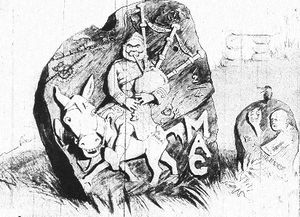
Among Wragge's critics were Augustus Hamilton (who visited the site), Alexander McKay, Professor AWP Thomas at Auckland University and Percy Smith.
Tregear and Macmillan Brown both commented more cautiously[19], both drawing attention to their earlier publications of a megalithic site near Kerikeri. What they presumed to be the same location had publication in Macmillan Brown[20] though to Macmillan Brown they were a works of primitive man with no hint of giants or a sunken continent, and again in Tregear, "There are sacred stones looking like Druidical remains at a place between Kerikeri and Kaitaia, Bay of Islands. These were anciently used in sun-worship and are known as Nga Whaka-ra-ra, or Te Hakari. They were used as posts around which pyramids of food were piled at the annual feast of Ra, the Sun." [21]. Tregear here is virtually quoting White here[22].
One account makes it clear the supposed megaliths were in at least two locations[23]. Hamilton[24] is more specific on the location of one of them. Despite Wragge himself apparently never revealing the exact location of the sites they have continued to receive some attention. Rout[25] refers to it and Rout's reference gets quoted in Barry Fell's hyper-diffusionist America B C (1977) as well as on a blog decrying conventional views of New Zealand history as recently as 2005.
Clearly Wragge had little understanding of the physics applicable to planetary bodies, which was pretty well known by 1910.
Submerged Continent
In his 1906 book Wragge was certain of a submerged continent.
p257: …… it is certain that Rapanui once formed part of the submerged continent….; that a race of architects and scholars flourished down there some 300,000 years ago; that the writings on the rocks were contemporaneous with the efforts of the learned of the age to express themselves in written language anterior to Sanscrit; that beside them the ruins of South America are as children; the Sphinx and Pyramids are infants; and that Tahiti, Rarotonga, and some other islands of the Pacific Ocean, including Tonga-tabu, Ponapé and the Ladrone Islands * where remarkable ruins are found (with perhaps New Zealand) are remnants of that ancient land.”
- Marianas
His 1911 visit to Tonga was an archaeological excursion as well:
PRE-HISTORIC CIVILISATION. IMPORTANT DISCOVERIES AT TONGA. A RACE OF TITANS (Special to Herald) AUCKLAND, this day. Mr Clement Wragge, who has just returned from the Islands, where he obtained some fine photos of the eclipse of the sun was also actively engaged there in archaeological research work. He states that on the island of Telekinavau he found huge blocks of coralline rock, some of Titanic size, that had apparently been roughly hewn, and indicating evidently the remains of an old sea-wall allied to similar remains at Vakapa Island and elsewhere in the Carolines. Some of these he measured and photographed. He also saw most distinctly chiselled and cut deep into the hard coralline rock petroglyphs similar to those on the rocks near Raglan, New Zealand, and to those in New Caledonia, Hawaii, and elsewhere in the Pacific, These consist of a sun-spiral with- deeply carved rays, crude human figures (as at Raglan), circles, ovoids, cross, quaint star-like emblems, and others of immense antiquity that have withstood the ravages of vast ages. He examined sundry stone platforms in the Haapai group allied to those on Easter Island, as well as others at Tongatabu, and found all were erected more or less on the meridian (allowing for variation of the compass and the undoubted secular shift of the earth's axis). Probably the Tongans adopted these for graves, as a hermit crab will adopt a tube shell, but they did not originate them. One solid block is 17ft 4in m length, 2ft 3in broad, stands 3ft 8in out of the ground, and by. how much it is buried is at present unknown. It is impossible to believe that any Tongans allied to those of the present day could have manipulated such. It was giants' work. The natives say that bones of greater size than those of existing man have been found there. Many more monoliths and engravures, doubtless, are waiting to be unearthed in all the Friendly Islands, coupling up archeologically with the remains at Samoa and the Banks group, and joining also New Zealand and, New Caledonia with the Carolines, Hawaii, Tahiti, Borabora, the Marquesas and Easter Islands afford a unique field for further research, there is no manner of doubt whatever. Furthermore, it is now abundantly evident that the missing links connecting up more specifically the carvings at the Chatham Islands and Raglan, and also the Bay of Islands monoliths with those of Eastern Asia and South and Central America have now come to light, and that a Titanic and mystic race of architects and symbol carvers traversed the old land that once most surely joined up Asia and Malaya with Australia, New Zealand and America[26].
Wragge had visited the well known Raglan petroglyph site in December 1910 and photographed the site[27].
Wragge's linking of Easter Island to Lemuria was not original. Later the island was linked to the Lost Continent of Mu.
Wragge's spiritualism / Theosophy is almost certainly linked to his acceptance of sunken continents. Howe [28] notes the connection between prominent spiritualists such as Rudolph Steiner who published on the subject of Theosophy in 1904 and Scott-Elliot who published on Lemuria in 1904 - the latter publication more likely to have reached Wragge before 1906.
The references to Atlanteans and Lemurians relate to two of the five root races concept, of Theosophy founder Helena Blavatsky[29].
Easter Island
Of the unfinished research on the petroglyphs of Easter Island there is some trace in the family papers. A scrapbook of clippings which must have been sustained up to his death has many about Easter Island, including newspaper articles by Macmillan Brown, recently returned from a trip there. These were heavilly annotated with critical comments by Wragge. Included there is a manuscript by Wragge entitled The History of the Maori and Easter Island. There is also one clipping of a letter to the editor by Wragge, critical of Macmillan Brown over Easter Island[30]. A quote from it shows he had shifted his opinion a little on cultural origins: "...the Maori (since degenerated from the giants of old) is Atlantean in origin."
In Review
Wragge was a literate and numerate man of considerable accomplishment in his career and a skilled communicator. His approach was not that much different from better known contemporaries like Tregear or Macmillan Brown, and like them was little influenced by the developing discipline of archaeology elsewhere in the world. Yet he had no lasting influence on conventional archaeology in New Zealand or views of its prehistory. There is little evidence that he operated in communication with other scholars and his use of the popular press alone for publishing his views is likely to have reduced his credibility.
He appears to have been lead to some of his views on human history through his spiritualist beliefs and the literature relating to them. His fixation on a narrow range of comparative evidence over which there was no time control, in believing megaliths were beyond the scope of modern people, in vast time depth, in readily accepting marks as glyphs, adopting cataclysmic events as explanations, in deprecating the capabilities of Polynesians / Māori and believing in giant former inhabitants in the absence of any evidence, are all themes that have continued in alternative views of New Zealand history. He was not the originator of at least some of them. Yet he is not cited by the modern holders of such views and is presumably unknown to them. The persistence of the ideas invites explanation. Their adoption in Wragge’s case can be linked to intellectual isolation and perhaps in that of more modern believers as well.
References
- ↑ Ben Nevis Observatory http://ben-nevis.com/information/history/observatory/observatory.php Accessed Feb 2010
- ↑ Australian Dictionary of Biography, Wragge, Clement Lindley http://adbonline.anu.edu.au/biogs/A120646b.htm Accessed Feb 2010
- ↑ Federation and Meteorology: Clement Wragge. http://www.austehc.unimelb.edu.au/fam/0824.html Accessed Feb 2010
- ↑ Frazer, I. J. 2023, Rain god, the highs and lows of Clement Wragge, meteorologist with a mission. Silverbird Publishing.
- ↑ Wragge, C. 1906 The Romance of the South Seas. Chatto and Windus.
- ↑ Dickie, F 1922 Mysterious Easter Island. Popular Mechanics Dec:834
- ↑ THE WONDERS QF SCIENCE. Poverty Bay Herald, Volume XLII, Issue 13603, 3 February 1915, Page 4 Seen at Papers Past http://paperspast.natlib.govt.nz/cgi-bin/paperspast?a=d&cl=search&d=PBH19150203.2.40&srpos=15&e=--1915---1923--10--11----0wragge+lecture-all Accessed 2010
- ↑ Crocket, K 2005 The Ben Nevis mystery. The John Muir Trust Journal 38:19-20. On-line: http://www.jmt.org/assets/pdf/journals/journal-38-january-2005.pdf
- ↑ MS My Life, Auckland Institute and Museum Library.
- ↑ Eldred-Grigg, S 2010 The Great Wrong War, Random House, pp338-9.
- ↑ Historical Birkenhead. Members Stories: Clement L Wragge. http://www.historicbirkenhead.com/membersstories72.htm Accessed Feb 2010
- ↑ SERMONS IN STONES. Evening Post, Volume LXXIX, Issue 55, 7 March 1910, Page 7 seen at Papers Past http://paperspast.natlib.govt.nz/cgi-bin/paperspast?a=d&cl=search&d=EP19100307.2.70&srpos=16&e=-------100--1----0clement+wragge+ancient-all Accessed Feb 2010
- ↑ 'THE STONES OF KUPE' Evening Post, Volume LXXIX, Issue 89, 16 April 1910, Page 14 seen at Papers Past http://paperspast.natlib.govt.nz/cgi-bin/paperspast?a=d&cl=search&d=EP19100416.2.140&srpos=5&e=-------10--1----2%22rock+art%22-all Accessed Feb 2010
- ↑ THE MYSTIC MAORI PILLARS. Poverty Bay Herald, Volume XXXVII, Issue 12106, 26 March 1910, Page 2 seen at Papers Past http://paperspast.natlib.govt.nz/cgi-bin/paperspast?a=d&cl=search&d=PBH19100326.2.5&srpos=23&e=-------100--1----0clement+wragge+ancient-all Accessed Feb 2010
- ↑ INTERESTING DISCOVERY Colonist, Volume LII, Issue 12737, 8 March 1910, Page 4 Papers Past Accessed 2010, http://paperspast.natlib.govt.nz/cgi-bin/paperspast?a=d&cl=search&d=TC19100308.2.49&srpos=5&e=-------100--1----2AN+ANCIENT+CITY+OR+TEMPLE.--
- ↑ PREHISTORIC NEW ZEALAND Grey River Argus, 25 November 1910, Page 8 Seen at Papers Past http://paperspast.natlib.govt.nz/cgi-bin/paperspast?a=d&d=GRA19101125.2.45.3&cl=search&srpos=24&e=--1910---1910--10--21----2%22wragge%22-all Accessed February 2010
- ↑ Auckland Weekly News March 17 1910 Page 7.
- ↑ Auckland Weekly News April 14 1910 Page 16.
- ↑ Colonist, Volume LII, Issue 12742, 14 March 1910, p1. Accessed March 2010 at http://paperspast.natlib.govt.nz/cgi-bin/paperspast?a=d&d=TC19100314.2.4.8&e=-------10--1----2-all
- ↑ Macmillan Brown, J 1907 Maori and Polynesian. Hutchinson and Co, London p5.
- ↑ Tregear, E. 1904 The Maori Race. Archibald Dudingston Willis, Wanganui, on line at http://www.nzetc.org/tm/scholarly/tei-TreRace-t1-body-d20.html
- ↑ White, J. 1856 Maori Superstitions, A lecture for the Young Men's Christian Association, Auckland, Printed By Williamson and Wilson.
- ↑ New Zealand Herald March 8 2010
- ↑ New Zealand Herald April 5 1910
- ↑ Rout, E. 1926 Maori Symbolism, Harcourt Brace and Co. New York, p137.
- ↑ Poverty Bay Herald, Volume XXXVIII, Issue 12460, 20 May 1911, Page 5 Viewed Papers Past http://paperspast.natlib.govt.nz/cgi-bin/paperspast?a=d&d=PBH19110520.2.39&cl=search&srpos=7&e=-------10--1----0wragge+tonga-all Accessed 2010
- ↑ Press clippings and photographs in the Wragge family papers, Auckland Institute and Museum Library
- ↑ Howe, K 2003 The Quest for Origins. Penguin Books, Auckland p 153
- ↑ Helena Blavatsky 1888 The Secret Doctrine, the Synthesis of Science, Religion and Philosophy
- ↑ Southland Daily News October 19 1922
